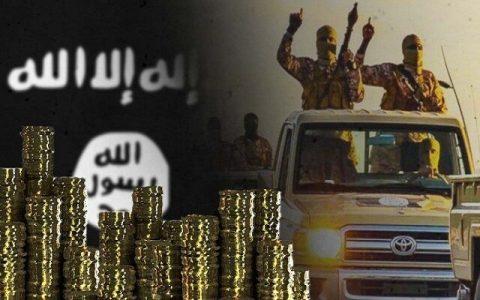
The Islamic State – one of the world’s richest terrorist organization
Following continued loss of territories to coalition forces, ISIS oil production procent continues to decrease by 16%. This is the result of the decline in oil and cement production after the terror group lost control of areas in Iraq and Syria, on the one hand, and air strikes that targeted its industrial facilities, on the other hand. According to the report, ISIS’s revenues fell in 2015 to $2.4 billion, down from $2.9 billion in 2014.
Total income from oil, gas, phosphates, cement and agriculture fell from $2.38 to $1.45 billion. Oil fell from $1.09 billion to $600 million, income from cement factories fell from $300 to $100 million, and agriculture fell to $255 million. A report by Huffington Post estimated that ISIS incomes today are as follows: taxes – $150-200 million yearly, oil – $150-200 million, smuggling of archeological artifacts – $50-100 million, ransom money – $25-50 million, donations – $20-40 million. As of June 2016, it is estimated that ISIS is generating between $40 million to $80 million a month in revenues.
Roughly, half of that amount is coming from taxes and fees, as well as expropriations and a variety of illegal activities. Its military operations are believed to cost it somewhere between $20 million and $30 million a month. Likewise, it is unclear what ISIS spends on administration and services. ISIS responded to its drop in revenues by raising tax and fines collection. A different estimates talks of revenues which reached $550 million in taxes. Ransom payments reached approx. $100 million in 2015 (compared with $120 million in 2014), and donation reached $50 million.
In Iraq, ISIS is left with two out of five oil fields, in partial production. This means that oil smuggling has decreased by 90%. Whereas in the past the organization sold at least 50 trucks of crude daily from Iraqi oil fields, it now sells barely 5 small trucks daily. In addition, coalition strikes against oil convoys force the organization to lower oil prices to lure oil traders to continue its smuggling.
It now sells an oil truck for $2000 in comparison with $6000 in the past. A truck driver from Mosul said that most traders have stopped buying oil from ISIS after numerous trucks were destroyed by coalition attacks and many truck drivers were killed.
In Syria, ISIS diesel prices have declined to the point of being almost the only product unaffected by rising prices. Diesel fuel originating from northern parts of Syria is priced at 110 Syrian pounds ($0.50) per liter. The reason for the continued low prices is ISIS’s desire to keep the demand for its oil derivatives high. The prices of other daily goods in the areas under ISIS control have skyrocketed, causing severe difficulties for local population.
The drop in income from oil and gas forces ISIS to rely more heavily on taxes and fines taken from the population under its control. A French report found that Chief among these is taxes on water and electricity, which amount to 800-900 million Euro yearly. The report further claimed that trade in artifacts, cigarettes, and drugs add another 150 million dollars to the account. Natural gas incomes for ISIS were $300 million. In addition, the report found that following the financial crisis, the number of fighters in ISIS ranks drops steadily since 2015, from 30,000 last year to 12,000 this year. The average age of recruitment was lowered to 16-17.
An increasing number of fighters flee and defect from the organization’s ranks, some of them after embezzling money from ISIS coffers. The wages for ISIS fighters were cut by half in several regions, as well as the salaries of ISIS civil servants’ wages. Due to the pressure on ISIS in Iraq and Syria, Libya has become a center for money transfer for ISIS.
Along the Euphrates river, ISIS draws income from fishing farms and sand quarries. Another source of income is the sale of permits to dig and trade in archeological artifacts, in return of 40% of the profits. Despite most of the reports of financial crisis, one senior officer in the Iraqi Intelligence Service claimed that the Islamic State is currently not suffering a financial crisis. This is because it still benefits from investments in commercial projects.
The source added that “the Islamic State leader and his cronies have invested a great deal of money in economic and commercial projects, which include dozens of car showrooms, commercial malls and construction projects. They have even taken part in the (Central Bank’s) auction of the dollar.” This money is transferred to ISIS via businessmen unrelated to ISIS, who serve as middlemen.
Some new fines imposed on the population are for holders of satellite dishes or TVs, as well as taxes levied on those wishing to leave ISIS controlled territories, and taxes on traders who import foods into Syria. In Deir a-Zour, ISIS has banned citizens from working for the Syrian government or in the territories under its control. It also closed down schools. This pushes youngsters to recruit to the organization, a result of poverty and lack of occupation.
Despite its financial crisis, ISIS continues to push for the spread of the use of its own currency – the golden Dinar, alongside the silver Dirham and the copper Fils. Traders are threatened with punishment if they continue using the Syrian or Iraqi currency or USD. Additionally, ISIS refuses to sell oil to merchants who are unable to pay with the new currency.




